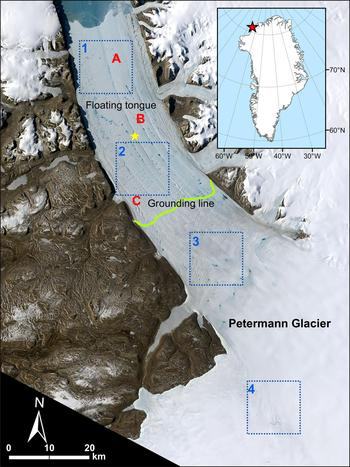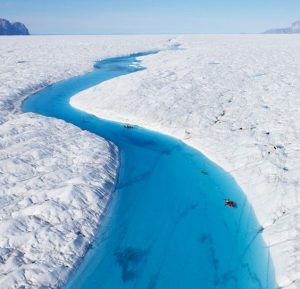by Sabrina Ho Yen Yin, GlacierHub

Conducted at Petermann Glacier’s floating tongue, a long and narrow sheet of ice protruding off the coastline. An ice tongue forms when a valley glacier advances rapidly out into the ocean. It has similar characteristics to an ice shelf, a feature more commonly found in Antarctica. Based on Landsat 8 satellite images from 2014 to 2016, the team was able to view the lakes over the area and discern when the lakes formed, their movement, and changes in surface extent across time.
In an interview with GlacierHub, MacAyeal explained, “Petermann Glacier has one of the few remaining ice tongues in Greenland and has lakes forming on it in each year. The glacier is of particular interest to the community due to its size and catchment, and the notable recent large calving events.”
The Petermann tongue underwent severe volume losses of up to 40 percent during two calving events in 2010 and 2012, for example. Fortunately, the grounded upper portion of the Petermann Glacier remains dynamically stable and showed little change in velocity or thickness.
“Glaciologists believe that supraglacial lakes store water and can become ‘dangerous’ to the continued existence of floating ice, such as the Petermann ice tongue, but more importantly to the ice shelves of Antarctica,” MacAyeal told GlacierHub. These supraglacial lakes usually form in the summer as melting is induced by an increase in air temperatures and solar radiation receipt. In the case of Greenland, the lakes at the Petermann Glacier typically fill in June, reaching their peak in July. At this time, the lakes are largest in area and volume, with their numbers at the maximum as well.
“The meltwater can fill cracks and cause them to extend through the ice. Also, when water flows into a depression and forms a lake, the lake is heavy and can cause the ice shelf to flex. Ice-shelf flexure can promote fracturing,” Macdonald further explained to GlacierHub. Fittingly, MacAyeal compares this to hydrofracking in the oil industry, except that this is a natural process when ice disintegrates as “heavy dense water fills crevasses and makes them crack farther open.”

Supraglacial lakes were under the spotlight when the formation of over 3,000 lakes caused the catastrophic disintegration of the Larsen B Ice Shelf in Antarctica in 2002. According to Grant, ice shelves are important as they shore up more than half of the Antarctic coast and several glaciers in Greenland. When this buttressing effect is removed the glaciers feeding the ice shelf accelerate. Without the ice shelves, more ice will enter the ocean at a faster rate, contributing to sea level rise.
Currently, the study indicates that supraglacial lakes cover less than 2.8 percent of the Petermann tongue, as compared to the 5.3 percent surface area prior to Larsen B’s collapse. However, there are warnings of higher density lakes with larger volumes that start developing earlier in the summer season due to higher air temperatures that could potentially destabilize ice shelves and tongues worldwide. “If we are to understand the future of ice shelves in a warming climate, we must understand supraglacial lakes,” Macdonald advised.

A Rendezvous with Landsat
NASA outreach specialists led educators through a workshop on accessing and utilizing Landsat data at the annual Earth Educators’ Rendezvous.





